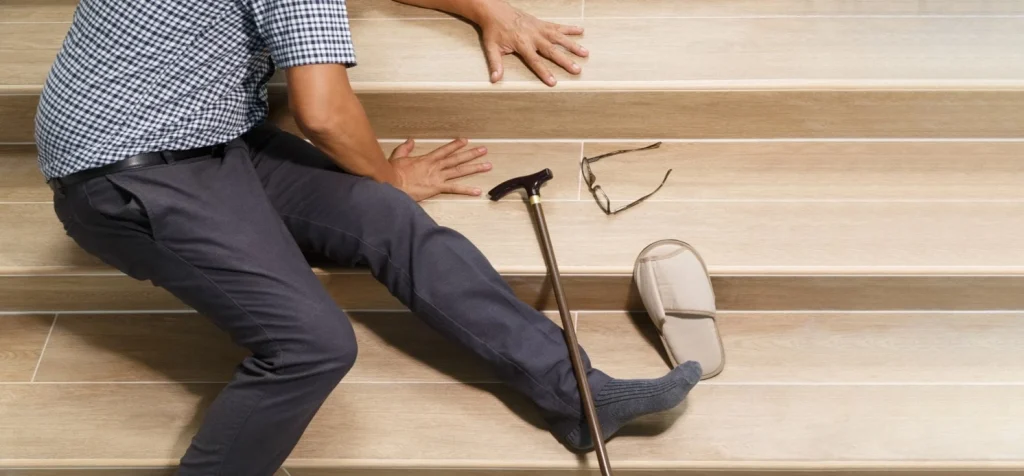
Causes of Loss of Balance in Elderly + Treatment
Falling is a relatively common issue among the elderly. Older adults don’t fall without reason, and if we don’t pay attention to the medical problems that arise in old age, we will continue to witness this. For example, a simple fall due to loss of balance in elderly can lead to more significant problems like bone fractures in older adults. Our walking and balance depend on our ears, eyes, legs, and brain.
With increasing age and the occurrence of numerous physiological changes, the physical abilities of individuals decrease. This leads to older adults having to grapple with various problems. One of the challenges that people may face in old age is imbalance. Imbalance in the elderly can have many symptoms and causes, so recognizing each of these can help you identify the problem that has arisen for your elderly loved ones and treat it as quickly as possible to prevent worse and more serious issues for them.
What Causes Loss of Balance in Elderly?
Balance problems in older adults often occur with increasing age, even for those who are in good health. Loss of balance occurs for various reasons, such as stiff or damaged joints or more serious issues like a neurological disease. However, inner ear problems are the most common causes of loss of balance in elderly. The vestibular system or labyrinth is a part of the inner ear that controls balance. When this system becomes infected or inflamed (a condition known as labyrinthitis), it causes vertigo, which leads to sensations like dizziness or spinning. Typically, labyrinthitis is the result of another illness or condition, including:
- Medication
- Head injury
- Upper respiratory infections
- Viral infections (sometimes bacterial infections)
- Circulatory system problems, such as stroke or low blood pressure
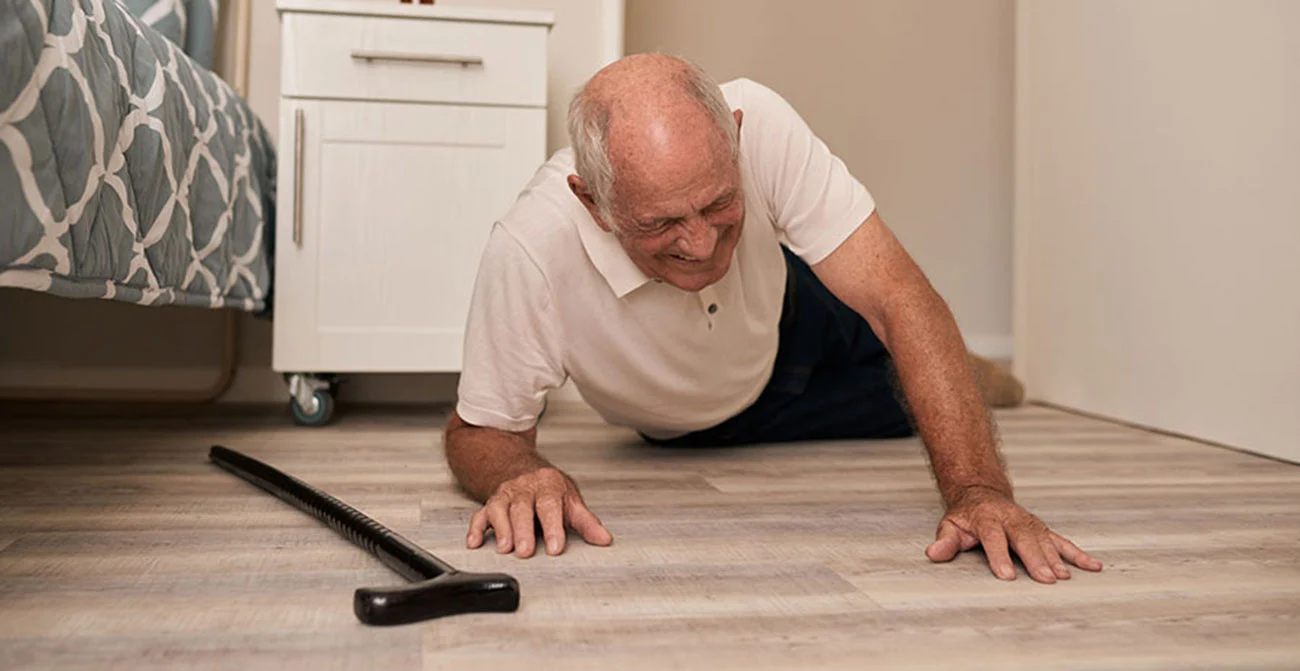
Older adults who experience loss of balance due to medication use should speak with their doctor and request a replacement. However, if a replacement is not available, a lower dose may be necessary.
Symptoms of Balance Disorders in Older Adults
If a senior has a balance disorder, he/she may experience symptoms such as:
- Blurred vision
- Confusion or disorientation
- Dizziness or a spinning sensation (vertigo)
- Lightheadedness, fainting, or a floating sensation
- Falling or feeling as if you are about to fall
Other symptoms may include:
- Diarrhea
- Feeling fearful
- Anxiety or panic
- Nausea and vomiting
- Changes in heart rate and blood pressure
Symptoms may appear in short episodes or persist for extended periods, leading to fatigue and depression in older adults.
Causes of Imbalance in the Elderly
Loss of balance in the elderly is one of the reasons for falls among older individuals. Fall recovery training and maintaining good balance with aging can help you remain independent and perform daily activities.
The Ophthalmology Causes of Loss of Balance in Elderly
Vision problems, such as chromatic aberration in old age, can cause gait disturbances in the elderly. Chromatic aberration is a disorder in which older adults cannot distinguish between closely similar colors and images, which is due to presbyopia in the elderly that occurs in the lens and retina.
In this disorder, older adults after the age of 65-79 cannot clearly distinguish dark green from light green or crimson from red. For example, the door and the wall might both be cream-colored, and the older person may not notice the difference and bump into the wall when passing through the doorway. Or, if the carpet on the stairs has a similar color to the floor, they may not realize the stairs and fall. To deal with this problem appropriately, the home environment should be designed so that similar colors are not placed next to each other; for example, place black next to white.
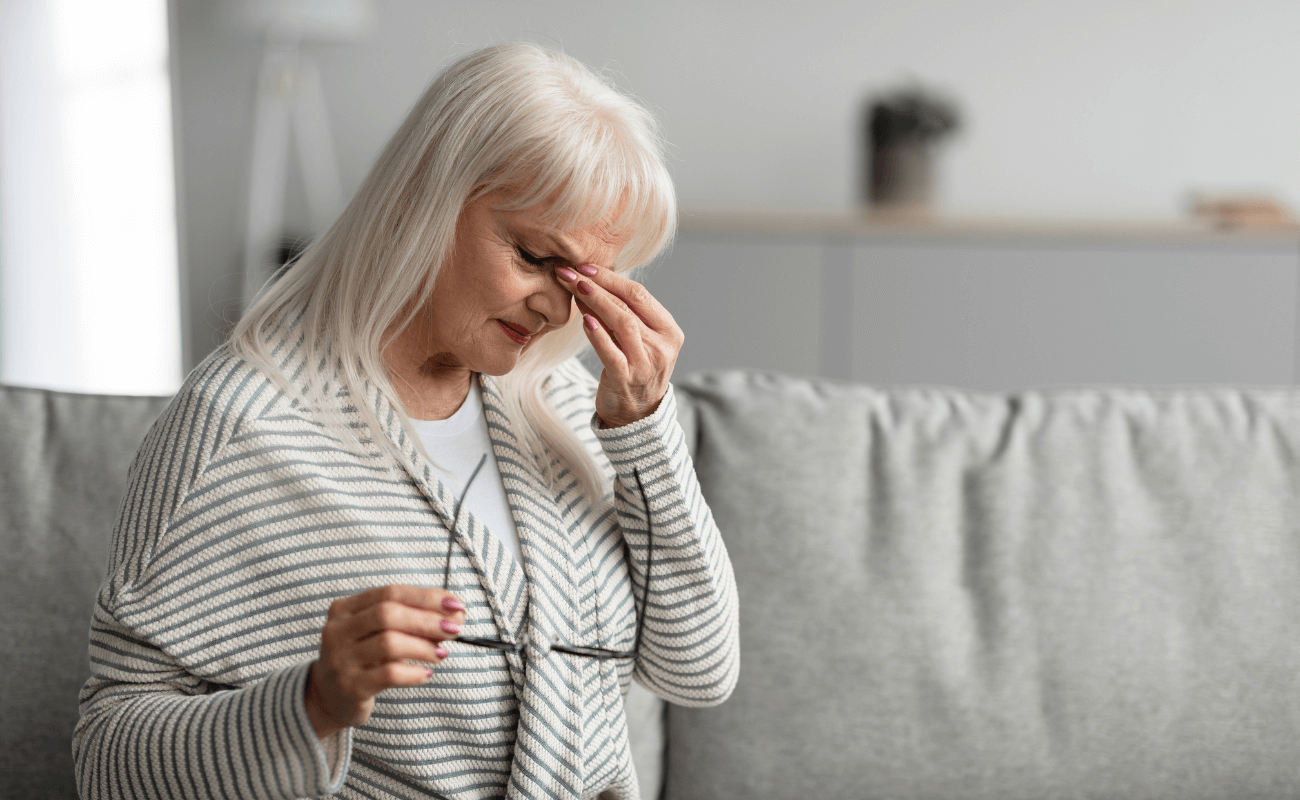
Falls Can Be Due to Blurred Eyesight in Older Adults
This is a problem that arises due to aging. In this disorder, the surface of the cornea, lens, and retina gradually deteriorates and becomes cloudy. This process will lead to a decrease in vision in the older adult. Cloudy vision may be due to diseases such as:
- Cataracts
- Glaucoma
With treatment or control of the disease, vision problems in older adults can largely be resolved.
Loss of Balance in Elderly Due to Light Sensitivity
This means that older adults need more light to perform tasks they could previously do with less light. Older adults need three times as much light as younger people. This is why we often see grandparents trying to illuminate the house. Because they cannot see well in low light, and not seeing well leads to falls in older adults. Pay attention and let the lights stay on.
Combination Problems for Loss of Balance in Elderly
This is a problem that occurs in both the ear and the eye of the older adult. Older adults who have hearing loss and also have difficulty seeing cannot recognize people well. These individuals experience an imbalance in recognizing people and their surrounding environment, which leads to falls. What is the appropriate solution? Referral to an otolaryngologist (ENT specialist) and an ophthalmologist separately, and prescribing hearing aids and treating dry eye or cataracts, etc.
Orthopedic Causes of Loss of Balance in Elderly and Falls
What is a sign of imbalance in walking? The roots of falls in older adults are numerous. In this section, the reasons for this occurrence will be examined from an orthopedic perspective so that we can become familiar with more precise and clearer reasons. After becoming familiar, you can more logically use this information to improve the condition of your elderly loved one.
The movements of all human bodies are controlled by the brain. If this organ malfunctions due to diseases such as tumors, tremors, and Parkinson’s disease, which are seen in older adults, the older person cannot maintain their body’s balance well.
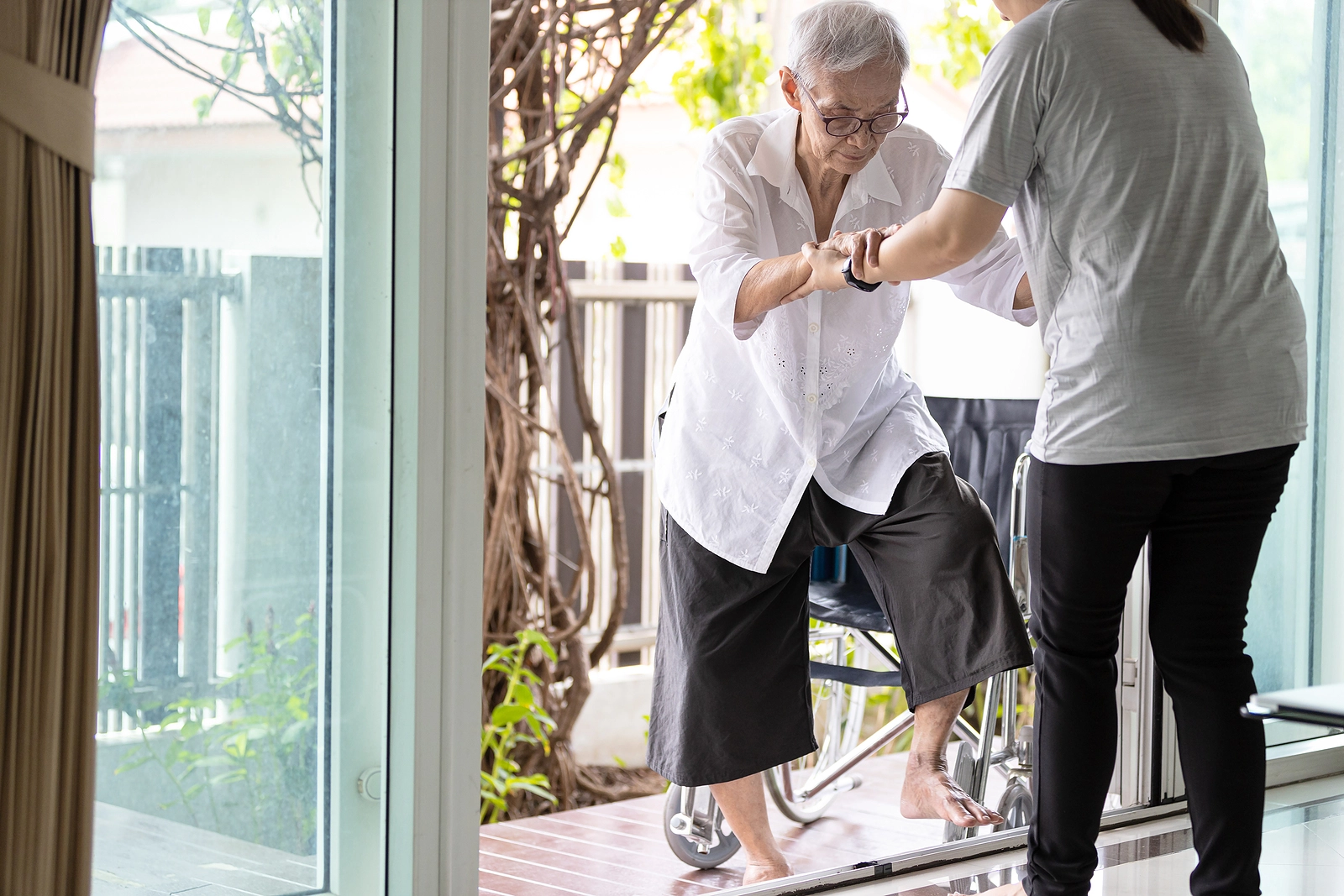
Note: Aging of the brain cause brain reflexes to decrease, and the older person cannot react to obstacles in time. Patients who have had a stroke also have very slow movements, and reflexes are very delayed. Brain exercises for elderly are one of the best treatments.
The likelihood of spinal stenosis increases with age. In these cases, there is increased pressure on the spinal cord. Such individuals experience heaviness in the pelvis, thighs, and legs when walking and become tired after walking 100-200 meters, causing them to stop. Chronic spinal stenosis gradually leads to weakness in the muscles around the pelvis and thighs in older adults. Weakness reduces muscle strength and the body’s reaction. In fact, the nervous system coming from the spinal cord has a problem.
In joint-related issues, the lower limb experiences a decrease in joint movement for any reason. Of course, the main cause of this problem is usually arthritis. When a joint does not move sufficiently, it adopts a position to reduce pain. This is why, if we look at the feet of older adults, we usually notice an inward rotation of the foot. These individuals usually do not have problems on flat surfaces, but weakness is clearly seen on uneven and sloping surfaces.
Neurological Causes of Imbalance in Older Adults
Falling, tripping, and loss of balance in elderly are usually multifactorial. It is not possible to give a clear opinion about the cause of imbalance in older adults without a thorough examination. However, some of the main causes from a neurological perspective are mentioned below.
Falls in older adults may be due to disorders of the musculoskeletal system. Osteoarthritis is the most common joint disease in older adults. Joint stiffness and pain in osteoarthritis can cause an older person to fall.
Another common cause seen in older adults is atherosclerosis, which is very important. In this condition, the flexibility of the blood vessels is lost. When blood vessels are in this state and the older person intends to change position from lying down to sitting and standing, the blood supply to the brain is delayed, which causes dizziness, blurred vision, and falls. If the patient has high blood pressure or diabetes, the blood supply disorder in the brain will be much greater and more severe.
Hypothyroidism is a very common cause of loss of balance in the elderly that can lead to falls. People who suffer from neurodegenerative diseases are also at risk of falling.
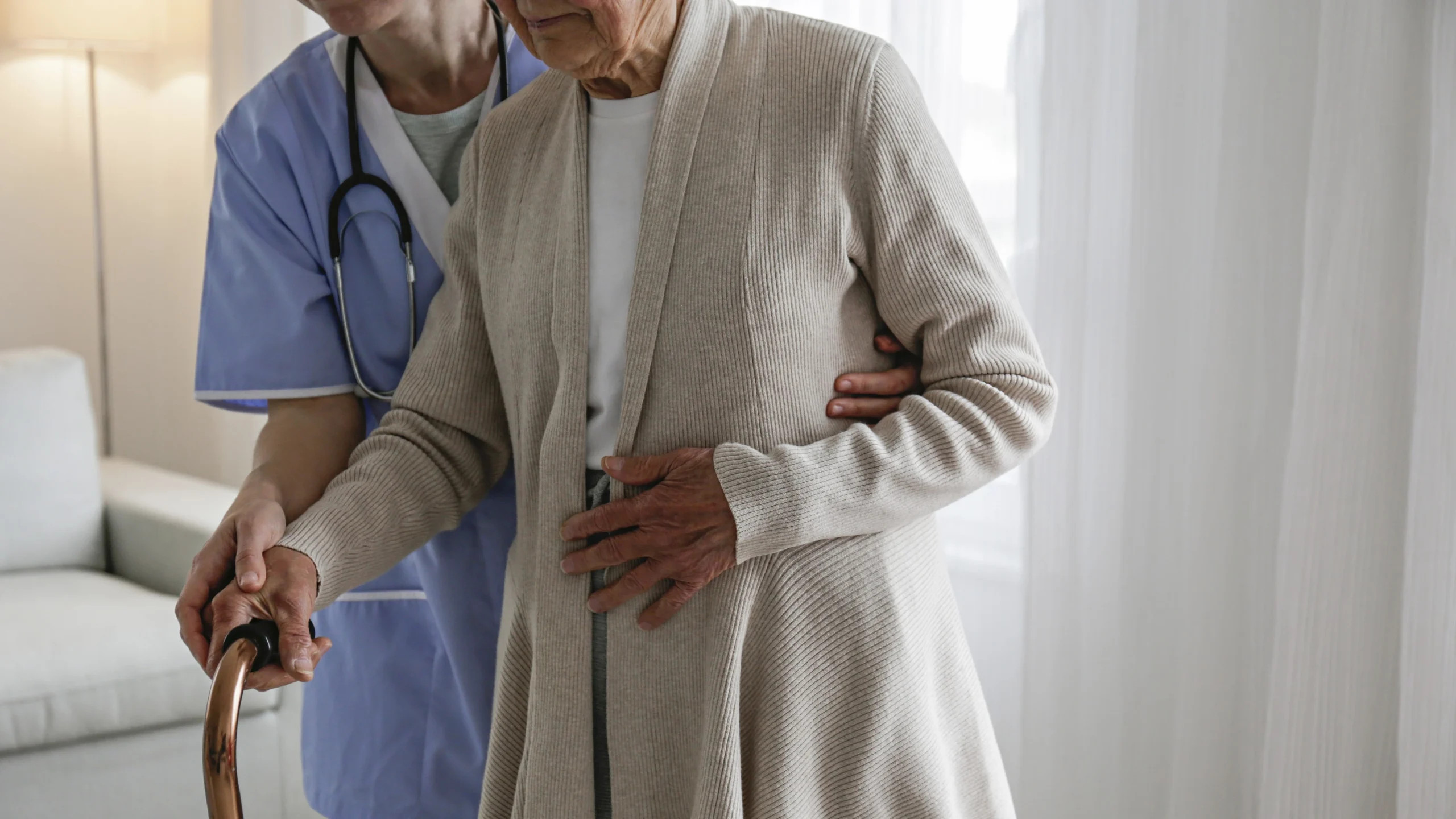
Side Effects of Medications in Older Adults
For many individuals, old age is accompanied by various illnesses and, consequently, the use of diverse medications. Some of the drugs that people take during this period can have various side effects, which in most cases affect the individual’s balance and function. Some of the medications that older adults need to take and that have side effects such as dizziness, imbalance in walking, and inability to move include the following:
- Blood pressure control medications
- Anticonvulsant medications
- Antidepressant and anti-anxiety medications
- Cardiovascular medications
The Impact of Heart or Respiratory Problems
The impact of heart or respiratory problems on imbalance in walking among older adults can be direct or indirect. When an individual’s heart has problems that affect its ability to pump blood, due to reduced blood flow and the failure to deliver nutrients to various parts of the body, especially muscles and bones, the person experiences imbalance in walking and an inability to perform their daily activities. In this condition, safe exercises for elderly with heart conditions have many benefits.
Respiratory problems and diseases also affect an individual’s ability by not delivering enough oxygen to the heart and consequently reducing oxygen supply to the muscles. Beyond the causes mentioned above, there are other factors that can influence imbalance in elderly gait. These include:
- Neurological Problems
- Physical damage such as pressure or trauma to nerves.
- Brain diseases like Parkinson’s or Alzheimer’s.
- Nerve disorders such as neuropathy caused by diabetes.
- Damage to the sense of touch.
Treating Loss of Balance in Elderly and Helping Elderly Walking
For the treatment of loss of balance in elderly, there are different pharmaceutical and non-pharmaceutical methods, each of which can have different results for different individuals. Effective methods for improving balance in older adults include the following, which you can discuss with your doctor:
Exercise and Balance and Muscle Rehabilitation Training
Exercise has the greatest impact on preventing pain! It is also beneficial for individuals with severe arthritis that has reduced their range of motion. The recommendation is to maintain limb mobility as much as possible. Inactivity leads to muscle weakness, and muscles lose even the remaining reflexes, but movement should be balanced with the level of ability.
Walking on a flat surface is also essential. It’s important to know how many minutes or hours of walking per day are beneficial for the legs. For example, if your legs hurt after an hour of walking, it’s best to reduce the walking time the next day. Or, you can divide the walking into segments, such as resting for a few minutes every 150 meters.
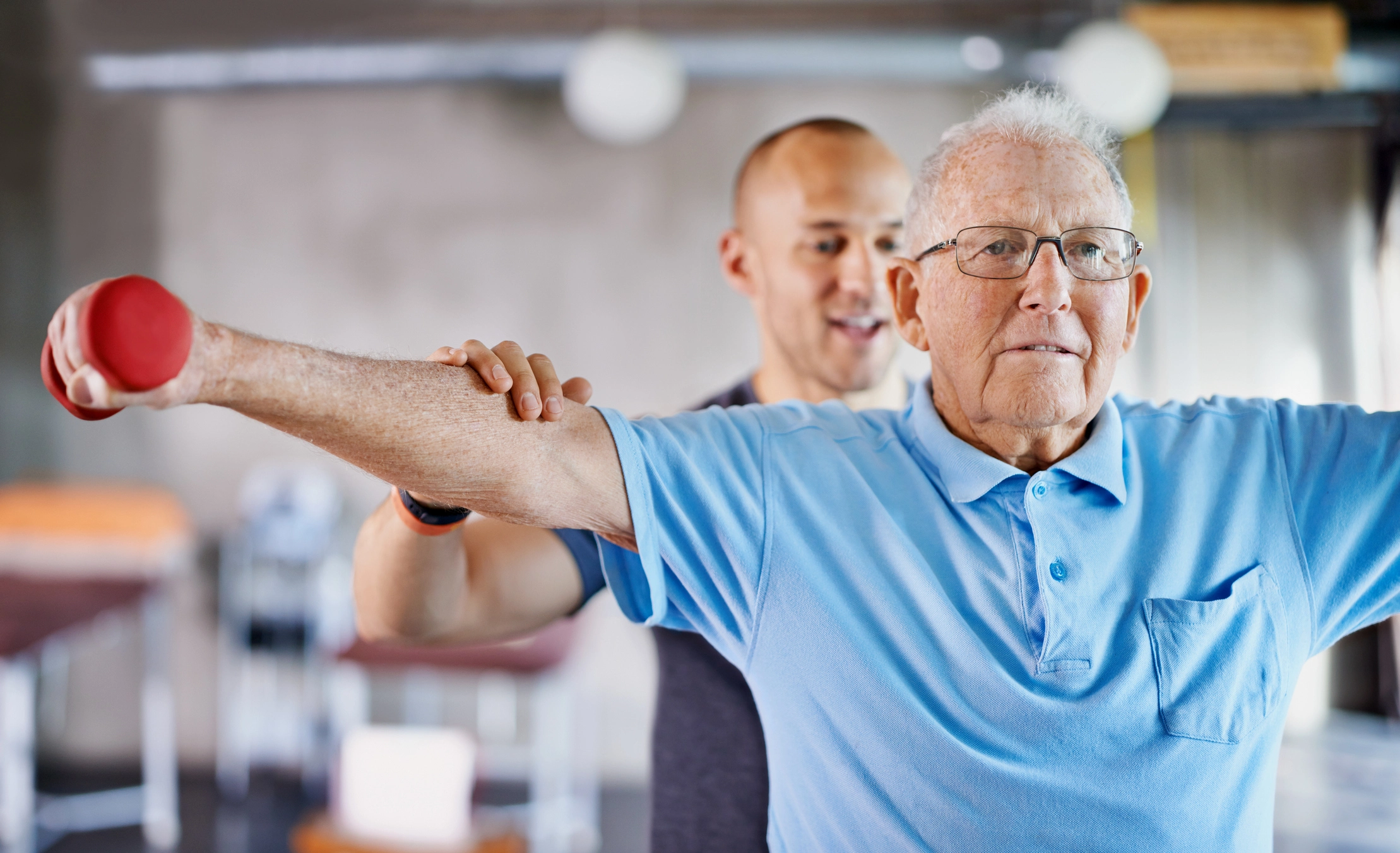
Performing balance and muscle rehabilitation exercises some effective balance exercises that orthopedic doctors and physiotherapists suggest for older adults with balance problems to regain their ability and improve their balance. Best dynamic balance exercises for seniors include static and dynamic exercises, and muscle rehabilitation exercises include stretching, flexibility, and strength training. Learn how to prevent falls during exercise for seniors.
Using Canes and Assistive Devices for Movement
If the problem of imbalance in elderly walking is severe, it is better for the individual to use assistive devices such as walkers or canes for their daily activities, such as walking. These devices and home safety equipment for elderly can help the older person move independently and easily perform all their personal tasks.
Whatever the cause of loss of balance in the elderly, using a cane is a helpful solution that is recommended. Older adults may show psychological and outward resistance to using a cane. By using a very small cane, older adults can become much more active than before and avoid falls.
Swimming in a Pool
Swimming is very beneficial for older adults who know how to swim. Although walking in the pool is also helpful, swimming has a greater impact. As you know, the pool:
- Is effective in various parts, especially strengthening muscles and joints
- Also helps to increase vitality and freshness in older adults
Avoiding Moments of Imbalance
Avoiding placing older adults in situations that cause imbalance in their walking. For example, if they get out of bed in the morning by turning to their left side:
- They should change their method of getting up
- They should definitely do this slowly
Consulting a Specialist (if necessary)
Benign cases of dizziness and imbalance in walking and standing improve spontaneously within 2-3 weeks, and sometimes a few months. Otherwise, advanced investigations are needed.
Lifestyle Changes
Older adults need to have a proper diet and regular physical activity to have a healthy and balanced body. In addition, consuming necessary vitamins and minerals such as vitamin D and calcium can have a significant impact on bone health and muscle function. When an older person’s diet is rich in essential nutrients such as iron, vitamin B, protein, etc., their nervous system and body muscles, especially their heart, will function optimally.
Concluding Remarks
When older adults experience loss of balance, it is necessary for someone to always be by their side and watch over them so that they do not fall or suffer serious injury if they lose their balance while walking and moving. In some cases, older adults may fall due to loss of ability and balance, and their bones may fracture.
Older adults don’t fall without reason, and if we don’t pay attention to the medical problems that arise in old age, we will continue to witness this. By understanding the cause of imbalance in older adults, we can prevent future problems and address the issue as quickly as possible. Maintaining the morale of older adults is very important.
We’ve shared our thoughts and now it’s YOUR turn! Please share your insights in the comments, and let’s start a meaningful discussion that will help others, too!

Frequently Asked Questions
How to prevent falls in older adults?
Falling in old age can have irreparable consequences. Therefore, it’s crucial to prevent this from happening as much as possible:
- Be careful that the elderly person doesn’t fall headfirst, as cerebral vessels are fragile at this age, and the likelihood of a brain hemorrhage is high
- Examine the inner ear of older adults who fall frequently and complain of dizziness
- Individuals with balance disorders should use a cane
When is imbalance in walking dangerous in the elderly?
- Experiencing severe and sudden dizziness and inability to move
- Prolonged dizziness
- Imbalance accompanied by chest pain or severe headache
- Blurred vision
